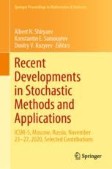Search
Search Results
-
A New Construction of Covariance Functions for Gaussian Random Fields
We develop a new approach to creating covariance functions for Gaussian random fields via point processes on the complex plane. We present two...

-
On Distribution of the Number of Peaks and the Euler Numbers of Permutations
Using the language of runs and patterns, a peak in a sequence of integers can be interpreted as observing a fall (or descent) immediately after a...

-
Introduction to Inferential Statistics 1: Random Variables
Inferential statistics aim at deriving generalized statements about a population based on data of a given sample of that population (see also Chap....
-
On Survival of Coherent Systems Subject to Random Shocks
We consider coherent systems subject to random shocks that can damage a random number of components of a system. Based on the distribution of the...

-
Random Variables
Based on the description of probability in Chap. 2 , let us now introduce and discuss several topics on random...
-
On Modification of the Law of Large Numbers and Linear Regression of Fuzzy Random Variables
Extreme properties of the average characteristics of fuzzy random variables are given. A new form of the law of large numbers for fuzzy random...
-
Normal Random Vectors
In this chapter, we consider normal random vectors in the real space. We first describe the pdf and cf of normal random vectors, and then consider...
-
Random forest based quantile-oriented sensitivity analysis indices estimation
We propose a random forest based estimation procedure for Quantile-Oriented Sensitivity Analysis—QOSA. In order to be efficient, a cross-validation...

-

-
Convergence of Random Variables
In this chapter, we discuss sequences of random variables and their convergence. The central limit theorem, one of the most important and widely-used...
-
Point process convergence for symmetric functions of high-dimensional random vectors
The convergence of a sequence of point processes with dependent points, defined by a symmetric function of iid high-dimensional random vectors, to a...

-
On Some Characterizations of Probability Distributions Based on Maxima or Minima of Some Families of Dependent Random Variables
Most of the characterizations of probability distributions are based on properties of functions of possibly independent random variables. We...
-
Simple random forest classification algorithms for predicting occurrences and sizes of wildfires
In order to formulate effective fire-mitigation policies, it is important to understand the spatial and temporal distribution of different types of...

-
On the test of covariance between two high-dimensional random vectors
We consider a problem of association test in high dimension. A new test statistic is proposed based on the covariance of random vectors and its...

-
Random Number Generator
This chapter explains how to use Excel to take a random sample of events or objects from a sampling frame that contains the list of events or objects...
-
Modeling random and non-random decision uncertainty in ratings data: a fuzzy beta model
Modeling human ratings data subject to raters’ decision uncertainty is an attractive problem in applied statistics. In view of the complex interplay...

-
Random Number Generator
This chapter explains how to use Excel to take a random sample of people (or objects) from a sampling frame that contains the list of people from...
-
Robust Optimal Design When Missing Data Happen at Random
In this article, we investigate the robust optimal design problem for the prediction of response when the fitted regression models are only...

-
Random Number Generator
This chapter explains how to use Excel to take a random sample of people (or objects) from a sampling frame that contains the list of people (or...
-
Random Number Generator
This chapter explains how to use Excel to take a random sample of events or objects from a sampling frame that contains the list of events or objects...
